Anaerobic and aerobic bacteria for septic tanks: we understand the rules for wastewater treatment
The best solution for processing sewage waste in suburban conditions is to install a local treatment facility - a septic tank or biological treatment station.
The components that accelerate the decomposition of organic waste are bacteria for septic tanks - beneficial microorganisms that do not harm the environment. Agree, in order to correctly select the composition and dose of bioactivators, you need to understand the principle of their operation and know the rules for their use.
These issues are discussed in detail in the article. The information will help local sewerage owners improve the functioning of the septic tank and facilitate its maintenance.
The content of the article:
Ecological recycling of sewage waste
Information about aerobes and anaerobes will be of interest to those who have decided buy a septic tank for a suburban area or wants to “modernize” an existing cesspool.
By selecting the right types of bacteria and determining the dosage (according to the instructions), you can improve the operation of the simplest storage type structure or establish the functioning of a more complex device - a two- or three-chamber septic tank.
Biological processing of organic matter is a natural process that has long been used by humans for economic purposes.
The simplest microorganisms, feeding on human waste, in a short period of time transform it into solid mineral sediment, clarified liquid and fat, which floats to the surface and forms a film.
The use of bacteria for household and sanitary purposes is advisable for the following reasons:
- Natural microorganisms that develop and live according to the laws of nature do not cause damage to the surrounding flora and fauna.This fact must be taken into account by owners of personal plots who use free territory for growing garden and vegetable crops, establishing lawns and flower beds.
- There is no need to purchase aggressive chemicals, unlike natural elements that negatively affect the soil and plants.
- The smell characteristic of household wastewater is felt much weaker or disappears altogether.
- The cost of bioactivators is small compared to the benefits they bring.
Due to the pollution of soil and water bodies, the environmental problem has affected summer cottages, villages and territories with new suburban buildings - cottage villages. Thanks to the action of hygiene bacteria, it can be partially solved.
There are two types of bacteria involved in the sewage system: anaerobic and aerobic. More detailed information about the vital functions of two types of microorganisms will help you understand the principle of operation of septic tanks and storage tanks, as well as the nuances of maintaining treatment facilities.
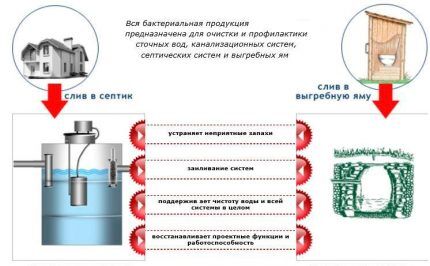
Basic principles of anaerobic treatment
Microorganisms that can function in an oxygen-free environment are called anaerobic bacteria or anaerobes. Let's try to figure out what place they occupy in the wastewater treatment system.
Where do anaerobes come from?
It should be understood that the strains of anaerobic bacteria for household septic tanks were not specially bred artificially (although the production of new, more active strains has now been established); they have always been part of nature.
Microorganisms that can exist without oxygen develop in swampy and simply damp soil, in silt, and in soil at great depths. Some species actively participate in the formation of humus and humus, formed by the rotting of dead plants and dead animals.
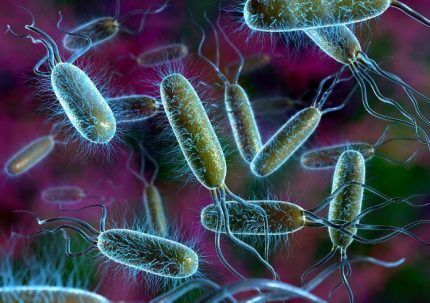
Anaerobic waste water is processed in sealed tanks. An example of such a container in a country house is an outdoor “birdhouse” toilet with cesspool. The fermentation process is carried out by anaerobic bacteria, which during their life processes produce methane and heat.
The anaerobic cleaning principle is also used in household devices (storage tanks, septic tanks) and industrial structures (digesters). Fermentation by anaerobes is actively used in livestock farms and poultry farms.
Conditions for the existence of bacteria
For the existence of microorganisms, special conditions are necessary, including:
- isolation - lack of oxygen, with the exception of facultative anaerobes;
- temperature regime — from +9ºС to +37ºС, optimal value – +28ºС;
- pH value — acidity level from 6 to 8;
- regularity of cleaning - removal of solid sediment.
As a result of the fermentation process, some substances sink to the bottom and rot, while others rise to the top. The liquid remains cloudy and often has a black tint. If a large amount of oxygen enters the tank, the bacteria can die.
Negative temperatures are also a primary threat, so it is recommended to insulate cesspools.

For normal life, anaerobes need a liquid medium, that is, at least 2/3 of the container must be filled with water. If you do not call the vacuum cleaners in time, the amount of solid sediment will reach a critical level and the bacteria will begin to die.
If the storage capacity does not correspond to the number of residents, the container will have to be emptied quite often - 2-3 times a month. Therefore, the choice of a septic tank must be carefully considered, the parameters assessed and compared with the upcoming operating conditions.
Read more about selecting a treatment plant in this article.
How does anaerobic treatment work?
The decomposition of organic matter in storage pits occurs in two stages. At first, you can observe sour fermentation, accompanied by a lot of unpleasant odor.
This is a slow process during which a primary sludge is formed that is marshy or gray in color and also emits a pungent odor. From time to time, pieces of silt break away from the walls and rise upward along with gas bubbles.
Over time, gases caused by acidification fill the entire volume of the container, displacing oxygen and creating an environment ideal for the development of anaerobic bacteria. From this moment, the alkaline decomposition of sewage begins - methane fermentation.
It has a completely different nature and, accordingly, different results.For example, the specific smell completely disappears, and the sludge takes on a very dark, almost black color.
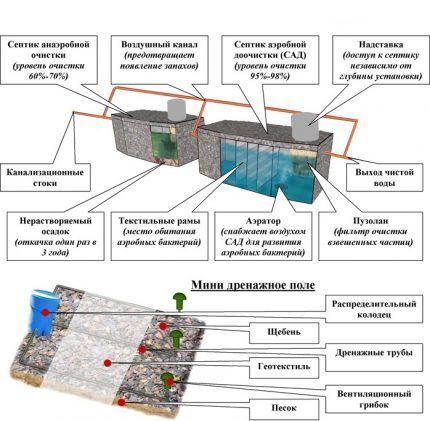
If a small part of alkaline sludge with anaerobes is placed in a storage tank or receiving chamber of a septic tank, the decomposition process will occur more efficiently, and the oxidation period will pass much faster.
In the absence of living sludge, it is necessary to purchase a bioactivator of suitable composition - a solution or dry substance in the form of tablets or powder, which is a complex of “dormant” anaerobic bacteria for the septic tank.
Thanks to anaerobes, waste biomass in a cesspool quickly breaks down into solid sediment, gases and liquid, and two-chamber septic tank purified approximately 65-70%.
Advantages of anaerobic treatment:
- small amount of bacterial biomass;
- effective mineralization of organic matter;
- lack of aeration, therefore saving on additional equipment;
- possibility of using methane (in large quantities).
The disadvantages include strict adherence to living conditions: a certain temperature, pH value, regular removal of solid sediment. Unlike activated sludge, precipitated mineralized substances are not a nutrient medium for plants and are not used as fertilizer.
VOC schemes using anaerobic bacteria
The simplest device in which anaerobic bacteria can live and multiply is a drainage pit. Modern cesspools are concrete or plastic sealed tanksinstalled in the ground below the freezing level.
Products made from HDPE can be purchased from specialized companies or on manufacturers' websites; concrete products - build from reinforced concrete rings independently, with the help or under the supervision of specialists.

The productivity of the structure increases with the advent of additional functional chambers. The most common designs have 2-3 compartments, the first of which acts as a sump, and the next ones as tanks for cleaning and clarification.
To create a favorable environment for the life of microorganisms, porous material, for example, crushed stone, is placed at the bottom of the container.
Additional purification of the clarified liquid occurs in filter well or at filter field, through which water enters the soil. Their construction requires a suitable type of soil (loam, sand, sandy loam), as well as a low groundwater level.

To maintain balance in the chambers, regular maintenance is necessary. It consists of removing solid sediment from the settling tank, pumping excess activated sludge from the second chamber to the first, adding bioactivators (in case of death or insufficient number of anaerobes).
Features of aerobic cleaning
Aerobes, unlike anaerobes, cannot exist without oxygen. They occupy their own, no less important, niche in the biological wastewater treatment system.
The conditions created for the development of anaerobes are absolutely unsuitable for the life of another type of bacteria - aerobes. They cannot form spores and grow in a confined space, deprived of air, and therefore process sewage.
For the aerobic system to reach its full potential, a vent is not enough; a forced supply of oxygen is necessary.
The air supply system for the aeration tank consists of several parts. The main function (air injection) is performed by compressor for septic tank. It is usually installed in a warm room inside the house, not far from the sewerage outlet. The air duct connects the compressor to the septic tank and runs in the same trench with pipes laid in the ground.
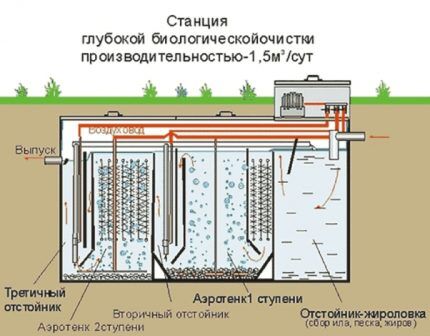
Saturation of wastewater with oxygen occurs using perforated tubes lowered into the water - aerators. The air supply can be regulated or completely shut off by valves located near the hatch.
Air comes out of the holes and, moving upward in the form of small bubbles, enriches the drains with oxygen. Aerators need to be cleaned from time to time so that the oxygen supply process does not stop.
When installing the first VOC, the problem arose of the gradual flushing of aerobic bacteria for the septic tank. It was solved by loading additional devices into the container - textile shields and plastic “brush brushes”.
Fine-pile fabric and bristles made of polymer material prevent the washout of activated sludge and serve as a basis for its growth.
As excess sludge accumulates, it is removed and used as fertilizer for growing vegetables, temporarily placed in compost heaps.
The main enemies of biological treatment are chemical detergents and antibiotics dissolved in sewage. They are destructive to various types of bacteria, so aggressive chemicals (for example, chlorine and solutions containing it) are prohibited from being poured into a septic tank.
Advantages and disadvantages of using aerobes
Almost all existing deep biological treatment stations incorporate aerobic chambers, since “oxygen” bacteria have some advantages over anaerobes.
They destroy dissolved impurities in water remaining after mechanical and anaerobic treatment. In this case, no solid sediment is formed, and the plaque can be removed manually.
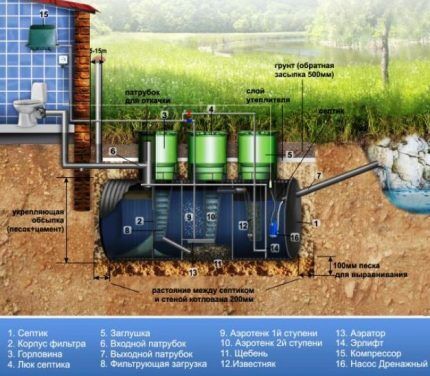
Activated sludge, which is the result of the activity of aerobes, is environmentally friendly and, unlike chemicals, benefits the vegetation growing on the site. Instead of the unpleasant odor characteristic of souring wastewater in cesspools, carbon dioxide comes out.
But the main advantage is the quality of water purification - up to 95-98%. The disadvantage is the energy dependence of the system.
In the absence of electrical power, the compressor stops supplying oxygen, and if left idle for a long time without aeration, bacteria can die.Both types of bacteria, aerobes and anaerobes, are sensitive to household chemicals, therefore, when using biological treatment, control of the composition of wastewater is necessary.
VOC schemes with aerobic treatment
The clarification of sewage wastewater with the help of aerobes is carried out in deep biological treatment stations. As a rule, such a station consists of 3-4 cameras.
The first compartment is a settling tank in which waste is divided into various substances, the second is used for anaerobic purification, and already in the 3rd (in some models and 4) compartment aerobic clarification of the liquid is carried out.

After three-four-stage treatment, the water is used for household needs (irrigation) or is supplied for additional treatment to one of the treatment facilities:
- filter well;
- filter field;
- infiltrator.
But sometimes, instead of one of the structures, ground drainage is installed, in which post-treatment occurs under natural conditions. In sandy, gravel and crushed soils, the smallest remains of organic matter are processed by aerobes.
Through clays, loams, and almost all sandy loams except the sandy and highly fractured variants, water will not be able to seep into the underlying layers. Clay rocks also do not undergo ground purification, because... have extremely low filtration qualities.
If the geological section of the site is represented by clay soils, soil post-treatment systems (filtration fields, absorption wells, infiltrators) are not used.
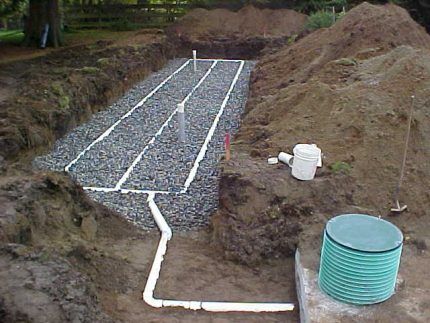
The filtration field is a branched system of perforated pipes (drains) extending from the distribution well. The treated wastewater flows first into the well, then into drains buried in the ground. The pipes are equipped with risers that supply oxygen needed by aerobic bacteria.
The infiltrator is a finished product made from HDPE, the last stage of VOCs for the post-treatment of clarified wastewater. It is buried in the ground next to the septic tank, placed on a drainage pad made of crushed stone. The conditions for installing the infiltrator are the same - light, permeable soil and a low groundwater level.
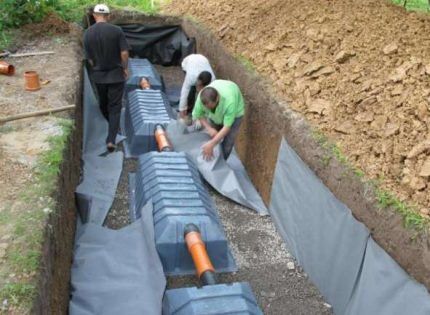
At first glance, a filter well resembles a storage tank, but has one significant difference - a penetrating bottom. The lower part remains open, covered with a 1-1.2 m drainage layer (crushed stone, gravel, sand). Ventilation and a technical hatch are required.
If additional treatment is not required, wastewater purified to 95 - 98% is discharged directly from the septic tank into a roadside ditch or ditch.
Rules for the use of bioactivators
To start or enhance the biological treatment process, sometimes additives are needed - bioactivators in the form of dry powders, tablets or solutions.
They replaced bleach, which did more harm to the environment than good.For the production of bioactivators, the most persistent and active strains of bacteria living in the soil were selected.
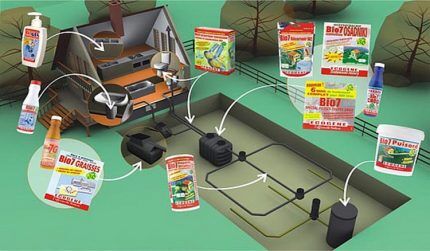
Drugs that help speed up the process of decomposition of organic matter usually have a universal complex composition, sometimes a narrowly targeted one. For example, there are starter varieties that help to “revive” the cleaning process after winter storage or long-term downtime.
Narrowly targeted types are aimed at solving a specific problem, for example, removing large amounts of grease from sewer pipes or breaking down concentrated soap effluents.
The use of bioactivators in VOCs and cesspools has a number of advantages.
Regular users note the following positive aspects:
- reduction in the volume of solid waste by 65-70%;
- destruction of pathogenic microflora;
- disappearance of the pungent sewer smell;
- faster cleaning process;
- prevention of blockages and siltation of various parts of the sewer system.
For rapid adaptation of bacteria, special conditions are required, for example, a sufficient amount of liquid in the container, the presence of a nutrient medium in the form of organic waste, or a comfortable temperature (on average from +5ºС to + 45ºС).
And do not forget that living bacteria in a septic tank are threatened by chemicals, petroleum products, and antibiotics.
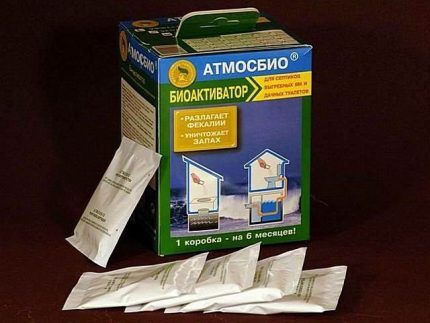
The market for biological products does not experience a shortage; in addition to domestic brands, foreign ones are also widely represented. The most famous brands are “Atmosbio", "Doctor Robik", "BioExpert", "Vodograi", "Sanex", "Microzim Septi Treat", "Biosept".
Conclusions and useful video on the topic
The presented videos contain useful material on the selection and use of biological drugs.
Practical experience of using bioactivators in the village:
Video review of the bioactivator “Harvesting Power”:
Review of the biological product "Economy Dacha":
Rules for using the Vodograi bioactivator:
As you can see, using live bacteria for cesspools or septic tanks helps to quickly and economically solve the problem of sewage treatment.
Microorganisms increase the efficiency of VOCs without causing harm to the environment. To create the most comfortable conditions for the life of bacteria, follow the instructions and do not forget to maintain the treatment facilities on time.
If you have anything to add, or have any questions on the topic of choosing and using bacteria for septic tanks, you can leave comments on the publication. The contact form is located in the lower block.




Great method.
This is truly a great way. I process sewage using this method myself, it works really well and quickly. These bacteria do their job very well. Don’t worry, they are really completely harmless, somehow I’m alive. But before you begin the processing process itself, read everything that is written here. You need to know how to do this, under what conditions to store these bacteria, etc.
Of all the biological products tested, “Russian Bogatyr” showed the best results. The smell disappeared on the second day and the septic tank also stopped pumping, because... bacteria and decompose all organic matter. I recommend it, a productive drug.
Hello, please tell me
I have a bioseptic tank with a compressor, and feces do not decompose